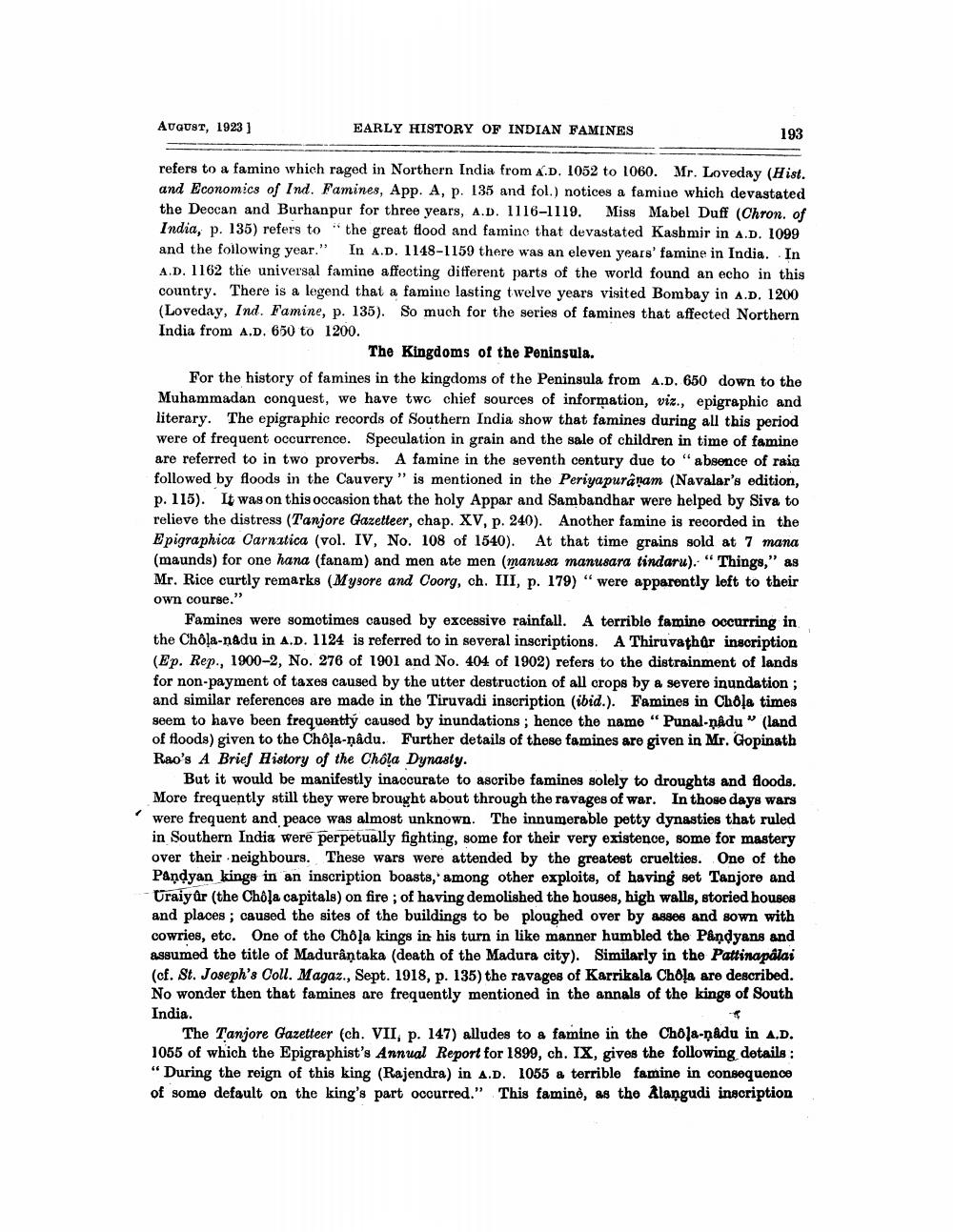________________
AUGUST, 1923)
EARLY HISTORY OF INDIAN FAMINES
193
refers to a famino which raged in Northern India from A.D. 1052 to 1060. Mr. Loveday (Hist. and Economics of Ind. Famines, App. A, p. 135 and fol.) notices a famine which devastated the Deocan and Burhanpur for three years, A.D. 1116-1119. Miss Mabel Duff (Chron. of India, p. 135) refers to the great flood and famine that devastated Kashmir in A.D. 1099 and the following year." In A.D. 1148-1159 there was an eleven years' famine in India. In A.D. 1162 the universal famine affecting different parts of the world found an echo in this country. There is a legend that a famine lasting twelve years visited Bombay in A.D. 1200 (Loveday, Ind. Famine, p. 135). So much for the series of famines that affected Northern India from A.D. 650 to 1200.
The Kingdoms of the Peninsula. For the history of famines in the kingdoms of the Peninsula from A.D. 650 down to the Muhammadan conquest, we have two chief sources of information, viz., epigraphic and literary. The epigraphic records of Southern India show that famines during all this period were of frequent occurrence. Speculation in grain and the sale of children in time of famine are referred to in two proverbs. A famine in the seventh century due to "absence of raia followed by floods in the Cauvery” is mentioned in the Periyapuranam (Navalar's edition, p. 115). It was on this occasion that the holy Appar and Sambandhar were helped by Siva to relieve the distress (Tanjore Gazetteer, chap. XV, p. 240). Another famine is recorded in the Epigraphica Carnatica (vol. IV, No. 108 of 1540). At that time grains sold at 7 mana (maunds) for one hana (fanam) and men ate men (manusa manusara tindaru). "Things," as Mr. Rice curtly remarks (Mysore and Coorg, ch. III, p. 179) " were apparently left to their own course."
Famines were somotimes caused by excessive rainfall. A terrible famine occurring in the Cho!a-nadu in A.D. 1124 is referred to in several inscriptions. A Thiruvathar inscription (Ep. Rep., 1900-2, No. 276 of 1901 and No. 404 of 1902) refers to the distrainment of lands for non-payment of taxes caused by the utter destruction of all crops by a severe inundation ; and similar references are made in the Tiruvadi inscription (ibid.). Famines in Chola times seem to have been frequently caused by inundations ; hence the name “Punal-nadu" (land of floods) given to the Chôļa-ņâdu. Further details of these famines are given in Mr. Gopinath Rao's A Brief History of the Chola Dynasty.
But it would be manifestly inaccurate to ascribe famines solely to droughts and floods. More frequently still they were brought about through the ravages of war. In those days wars were frequent and peace was almost unknown. The innumerable petty dynasties that ruled in Southern India were perpetually fighting, some for their very existence, some for mastery over their neighbours. These wars were attended by the greatest cruelties. One of the Pandyan kings in an inscription boasts,' among other exploits, of having set Tanjore and Uraiyûr (the Chola capitals) on fire ; of having demolished the houses, high walls, storied houses and places ; caused the sites of the buildings to be ploughed over by asses and sown with cowries, etc. One of the Chola kings in his turn in like manner humbled the Pandyans and assumed the title of Madurântaka (death of the Madura city). Similarly in the Pattinapalai (cf. St. Joseph's Coll. Magaz., Sept. 1918, p. 135) the ravages of Karrikala Choļa are described. No wonder then that famines are frequently mentioned in the annals of the kings of South India.
The Tanjore Gazetteer (ch. VII, p. 147) alludes to a famine in the Chola-nadu in A.D. 1055 of which the Epigraphist's Annual Report for 1899, ch. IX, gives the following details : "During the reign of this king (Rajendra) in A.D. 1055 a terrible famine in consequence of some default on the king's part occurred." This famind, as the Alangudi inscription




